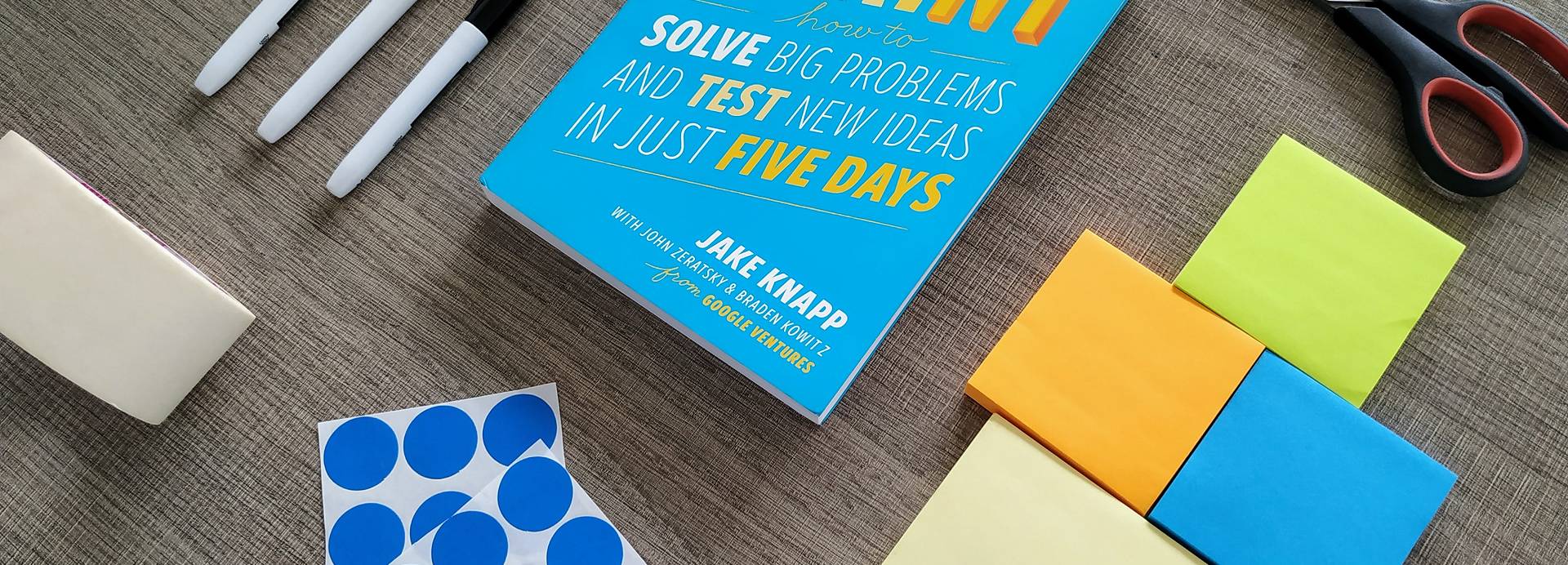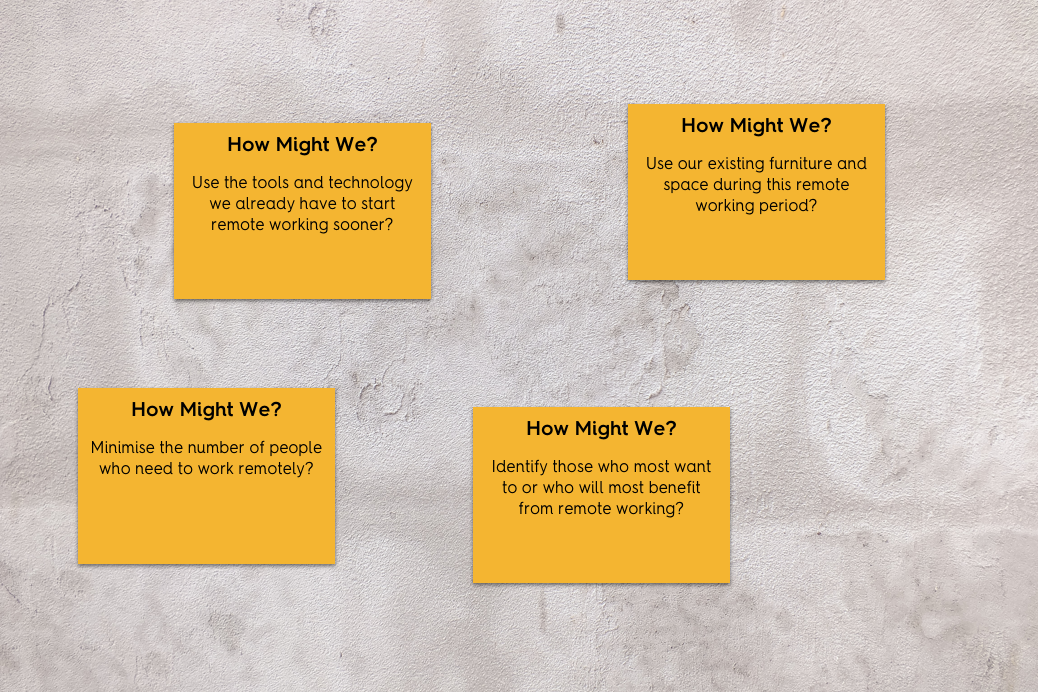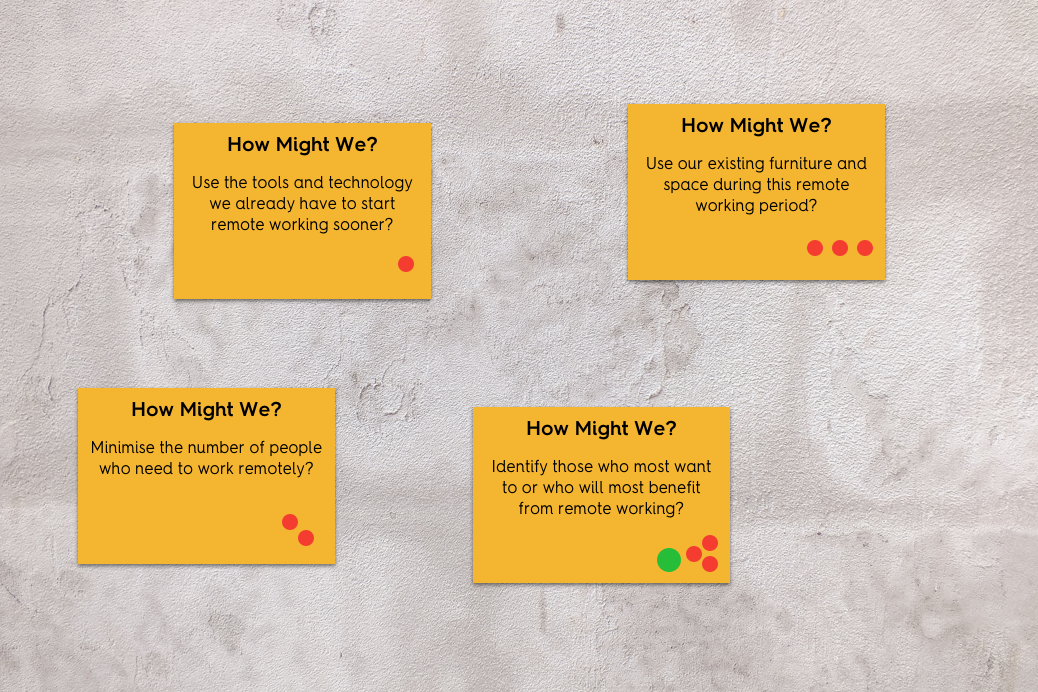
How Might We Questions - The Design Sprint Unpacked
Sixty Second Summary
In this series, we’re taking a look at the individual parts which make up a Design Sprint, how each part helps us work towards a user-tested prototype, and how you can use the activity on its own within your business’s Design-led decision making process.
Today, we take a look at the How Might We questions exercise that takes place during Ask the Experts, and how it helps you and your Design Sprint Team reframe incoming information as questions you can answer during the Design Sprint.
How Might We Questions
Though it may seem awkward at first, especially amongst certain members of the team, the use of How Might We questions to take notes is a great way to end up with questions that are both open-ended and optimistic, helping trigger creative thinking and finding an answer during the rest of the Sprint.
Taking How Might We Notes
Every person on the team will need their own stack of sticky notes (yellow, three by five inch Post-Its are good for this) and a thick black whiteboard marker.
To take notes during the Ask the Experts activity, or any activity, each member of the Sprint team should:
- Put the letters “HMW” (for How Might We) in the top left corner of their sticky note.
- Wait.
- When they hear something interesting, change it into a question (without disturbing the group).
- Write the question down on their sticky note.
- Peel the sticky note off and put it aside.
- Repeat.
By the end of the activity, each member of the team will have a stack of notes, each with a question on it, that you’ll organise later.
The Question Structure
Originally developed at Procter & Gamble in the 1970s, the How Might We questions activity has been designed and refined to help keep innovation and creativity flowing throughout the week. The exact structure of the questions we write has been through that same process, so there’s a lot of background to those three simple words we put at the beginning of each question.
How
The “How” suggests that we have yet to find the answer to the question. It helps us explore a variety of potential avenues instead of running ahead with what we think the solution should be.
Might
The “Might” suggests that for all the work we do to answer this question, the solutions we come up with are only possible solutions, they are not all of the solutions or perhaps even the “only” or “right” solution. This allows for exploration of multiple possibilities, instead of settling on the first thing that comes to mind.
We
The “We” element of the question implies that the Sprint Team will be working together to answer the question, rather than a lone wolf approach. This helps encourage teamwork, which is vitally important during the fast-pace nature and limited timeframe of the Design Sprint.

Examples of Good How Might We Questions
According to Stanford d.school, great How Might We questions have the following characteristics:
- They amp up the good in the insight or statement
- They focus on emotions and the human element
- They take it to the extreme
- They explore the opposite
- They question an assumption
- They create an analogy from insight or context
- They focus in on a single element
Obviously, you’re not looking to tick every box with every question, but if you are stuck for an idea for a question, these are good places to start at.
Answering the Questions
Once everyone has completed writing down their notes as “How Might We” questions, it’s time to start the process of answering them by deciding which of the questions we’re going to answer during our Design Sprint.

Voting on the Notes
Once all of the questions have been displayed on the whiteboard, or the virtual whiteboard if you’re doing a Remote Design Sprint, it’s time for the Sprint Team to decide which of the questions they’ll be answering. For this, we use Dot Voting, which works pretty much how you expect it would:
- Give to large dot stickers to each person
- Give four large dot stickers to the decided (as their opinion counts a little more)
- Ask everyone to read through and review the goal and sprint questions
- Ask everyone to vote in silence for the How Might We questions they think are most helpful.
- It’s okay for a member of the Sprint Team to vote for their own How Might We or give both their votes to the same How Might We, this just reinforces their vote.
Once voting has ended, you’ll have a cluster of dots on a few of the How Might We notes, meaning that the whole wall has now been prioritised. Anything without a vote on it has been deemed low priority, and can be recorded for later. The How Might We with the most votes is deemed the highest priority to answer, the note with the second highest number of votes is second highest priority, etc.
Once you have your small selection of prioritised How Might We’s, you can take them off the board and put them next to the appropriate step in your Map for each one, as they’ll likely match up. If you’re uncertain, have a quick discussion before making a decision and moving on.
Now that you’ve taken notes, voted on which ones are the highest priority, and mapped how they work with your previous research, we can move on to setting the Sprint Target, our singular purpose for the rest of the Sprint’s efforts.
Next Year
In our next issue, we bring together all we’ve done so far to create out Sprint Target, which sets the goal for the week’s activity. With the Christmas break, this piece will go live on 6th January 2021.
If you’d like to know when the next issue of The Design Sprint Unpacked drops, make sure to sign up to our newsletter or follow us on Twitter and LinkedIn.